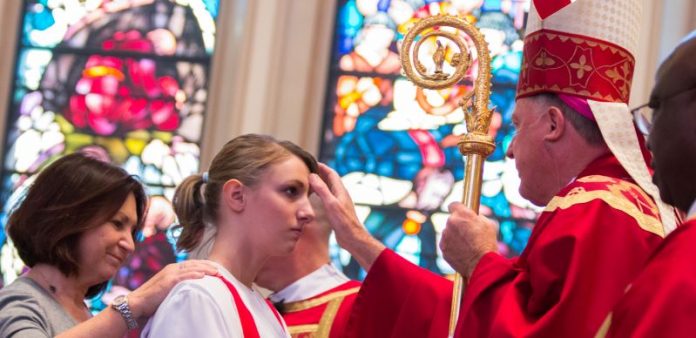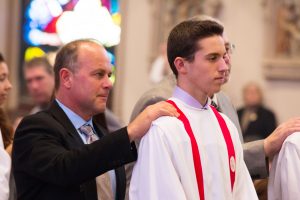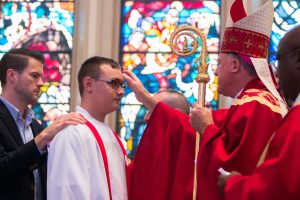
Catechesis on the sacrament of Confirmation
BISHOP ROBERT J. McMANUS
This article explains the nature and purpose of the sacrament of Confirmation. It will be divided into five parts, a structure that generally follows the section of Part II of the Catechism of the Catholic Church entitled “The Celebration of the Christian Mystery” where the sacrament of Confirmation is treated (see CCC, 1285-1321).
The nature and purpose of the sacrament of Confirmation
The sacrament of Confirmation is one of the three sacraments that are called the Sacraments of Initiation: Baptism, Confirmation, and Eucharist. Like all of the seven sacraments that constitute the Church’s “economy of salvation,” the sacrament of Confirmation confers upon the candidate an outpouring of the Holy Spirit with his sevenfold gifts and impresses upon the soul of the candidate “an indelible character.”
Through the reception of Confirmation, the candidate’s relationship to God the Father is deepened by the powerful grace of the Holy Spirit in and through the Risen and Glorified Christ. As Lumen Gentium, the Dogmatic Constitution on the Church of the Second Vatican Council, succinctly states:
By the sacrament of Confirmation, the baptized are more perfectly bound to the Church and are enriched with a special strength of the Holy Spirit. Hence they are, as true witnesses of Christ, more strictly obliged to spread and defend the faith by word and deed. (LG, 11)
Who should receive the sacrament of Confirmation?
Every baptized person should receive the sacrament of Confirmation. In the early centuries of the Church, Confirmation was conferred at the same time as Baptism. However, as the number of people who were being baptized grew, the bishop of the local church could not be present for every baptismal celebration. As a result, the time of celebrating Confirmation became separated from the day of one’s Baptism and was conferred by the local bishop at a different liturgical celebration.
In the Latin Church, the Code of Canon Law stipulates that Confirmation should be received at “the age of discretion (CIC, 891). However, when in danger of death, even children who have not reached the “age of discretion” should be confirmed (CCC, 1307). In the United States, the United States Conference of Catholic Bishops (USCCB) has established the pastoral practice of conferring the sacrament between the ages of 7 and 16, according to the decision of the local diocesan bishop.
Whatever the age of those who are to receive Confirmation, the catechetical preparation of the candidates is crucial for a fruitful reception of the sacrament. Some essential information that should be included in this proximate catechetical preparation includes the following:
1. The reception of Confirmation completes one’s initiation into the Mystical Body of Christ which is the Church. The Church is both universal and diocesan/parochial.
2. The activity of the Holy Spirit manifests itself frequently throughout the history of salvation. In the New Testament, particularly in the Resurrection narratives and in the Acts of the Apostles, it is clear that the reception of the Holy Spirit spiritually equips a Christian to carry on the evangelical mission that belongs to all the baptized. Simply stated, that evangelical mission is to become a joyful and bold witness to Christ and to live as an active and deeply committed member of the Church.
3. Part of the spiritual preparation for the proper reception of Confirmation is weekly attendance at Mass and the worthy reception of the Holy Eucharist, which deepens the life of grace in our souls. Since the regular reception of the sacrament of Penance and Reconciliation has greatly diminished in recent decades, candidates for the sacrament of Confirmation should go to confession as an immediate sacramental preparation.
4. The qualification and role of the sponsor in the celebration of Confirmation should be high- lighted. In so doing, the relationship between the role of a sacramental sponsor both at Baptism and Confirmation can be explained and clarified. Such catechetical instruction can impress on the candidate the privilege and responsibility that will be theirs if and when they are invited to exercise this “spiritual accompaniment” in the life of a fellow Catholic.
The minister of the sacrament and the Rite of Confirmation
 The bishop is the ordinary minister of the sacrament of Confirmation, although he can delegate a priest to confirm for pastoral necessity. As a successor to the Apostles, the bishop is a visible link in his diocese to the apostolic foundation of the Church. By virtue of his episcopal office, the bishop has the responsibility of fostering the unity and orthodoxy of the local church confided to his pastoral care. Through the prayer of the Church and the imposition of the bish- op’s hands, the candidate for Confirmation completes his or her initiation into the Church.
The bishop is the ordinary minister of the sacrament of Confirmation, although he can delegate a priest to confirm for pastoral necessity. As a successor to the Apostles, the bishop is a visible link in his diocese to the apostolic foundation of the Church. By virtue of his episcopal office, the bishop has the responsibility of fostering the unity and orthodoxy of the local church confided to his pastoral care. Through the prayer of the Church and the imposition of the bish- op’s hands, the candidate for Confirmation completes his or her initiation into the Church.
The actual Rite of Confirmation contains several symbols and symbolic gestures that are rich in theological meaning. The main symbol used in the liturgical rite is sacred chrism. Customarily the bishop consecrates chrism at the Chrism Mass celebrated during Holy Week. Chrism is used in three of the Church’s seven sacraments. During the celebration of infant Baptism, the child’s head is anointed with chrism in the sign of the cross, uniting the child to Christ who is Priest, Prophet, and King. When a man is ordained a priest or a bishop through the sacrament of Holy Orders, sacred chrism is used. In the case of a newly ordained priest, his hands are anointed with sacred chrism, empowering him to celebrate the Holy Sacrifice of the Mass, and on the day a priest is ordained a bishop, his head is anointed with chrism, more deeply conforming him to Christ, the Head of the Church.
Yet before the Confirmation candidate’s forehead is anointed with chrism, the candidates must renew their baptismal promises by means of which they renounce Satan and all his evil works and profess their Catholic faith. This liturgical action highlights the sacramental relationship between Baptism and Confirmation as Sacraments of Initiation.
Immediately after the renewal of the baptismal promises, the bishop extends his hands over the heads of the kneeling candidates and prayerfully invokes the outpouring of the Holy Spirit. This liturgical gesture of imposing hands has deep scriptural roots. One such scriptural passage that clearly indicates the sacramental relationship between the imposition of hands and the bestowal of the gift of the Holy Spirit is the following:
Now when the apostles in Jerusalem heard that Samaria had accepted the word of God, they sent them Peter and John, who went down and prayed for them, that they might receive the holy Spirit. … Then they laid hands on them and they received the holy Spirit. (Acts 8:14-15, 17)
After the ritual imposition of his hands, the bishop anoints the forehead of the candidate and pronounces the words that constitute the “form” or essence of the sacrament: “Be sealed with the Gift of the Holy Spirit.” The liturgical rite of the sacrament of Confirmation ends with the exchange of the sign of peace between the bishop and the newly confirmed.
The effects of Confirmation
A sacrament is an outward sign, instituted by Christ, that confers certain interior sacramental effects within the lives of the Church’smembers. The chief sacramental effect of Confirmation is the outpouring of the Holy Spirit and the bestowal of the Spirit’s sevenfold gifts. However, other spiritual effects flow from the bestowal of the gift of the Holy Spirit. There is a deepening of the grace, first received at Baptism, that strengthens our relationship with the Blessed Trinity — that is to say, our belonging to God our Father through Jesus Christ, his Son, in the power of the Holy Spirit. The reception of Confirmation completes one’s initiation into the Church and strengthens one in the power of the Holy Spirit to “spread and defend the faith by word and action as true witnesses to Christ, to confess the name of Christ and never to be ashamed of the Cross” (CCC, 1303).
Confirmation also impresses upon the soul “an indelible character” or “seal.” As the Catechism of the Catholic Church teaches:
Because this seal indicates the indelible effect of the anointing with the Holy Spirit in the sacraments of Baptism, Confirmation and Holy Orders, the image of the seal has been used … to express the indelible “character” imprinted by these three unrepeatable sacraments. (CCC, 698)
A word of encouragement to catechists
 The diocesan bishop is the chief teacher of the Church’s tradition of faith and morals in his local church. Yet he cannot fulfill this crucial and demanding pastoral role without competent collaborators, among whom are his diocesan catechists. To pass on intelligently and effectively the faith of the Church in a deeply secularized society like the United States is a pressing pastoral challenge. Every catechist, especially those who are catechizing young people in preparation for the reception of Confirmation, knows this challenge firsthand. Yet while the challenge is real and sometimes overwhelming, catechists can play a significant role in evangelizing their students not only as well-informed teachers but also as mature, Catholic adult witnesses who are proudly committed to the practice of the faith.
The diocesan bishop is the chief teacher of the Church’s tradition of faith and morals in his local church. Yet he cannot fulfill this crucial and demanding pastoral role without competent collaborators, among whom are his diocesan catechists. To pass on intelligently and effectively the faith of the Church in a deeply secularized society like the United States is a pressing pastoral challenge. Every catechist, especially those who are catechizing young people in preparation for the reception of Confirmation, knows this challenge firsthand. Yet while the challenge is real and sometimes overwhelming, catechists can play a significant role in evangelizing their students not only as well-informed teachers but also as mature, Catholic adult witnesses who are proudly committed to the practice of the faith.
In December 1975, Pope St. Paul VI issued a papal document that has retained its ecclesial importance to our every day when the new evangelization has a prominent place in the Catholic Church’s self-understanding. The document is Evangelii Nuntiandi (“On Announcing the Gospel”). One passage from that document is particularly pertinent to catechists: “The modern person listens more willingly to witnesses than to teachers and if he or she does listen to teachers, it is because they are witnesses” (EN, 41).
Catechists are both teachers and witnesses who play a pivotal role in the singular privilege and responsibility of deepening the personal acceptance of the faith of their students, a faith which is first and foremost a supernatural gift of the Holy Spirit.
Most Reverend Robert J. McManus is the fifth Bishop of Worcester, Massachusetts. Ordained as a priest in 1978, Pope John Paul II elevated him as an Auxiliary Bishop of Providence in 1999. He was later installed as Bishop in Worcester on May 14, 2004.
This article was originally published in Catechist magazine, October 2019.
Photos: Michael Doyle, Bayard, Inc.




